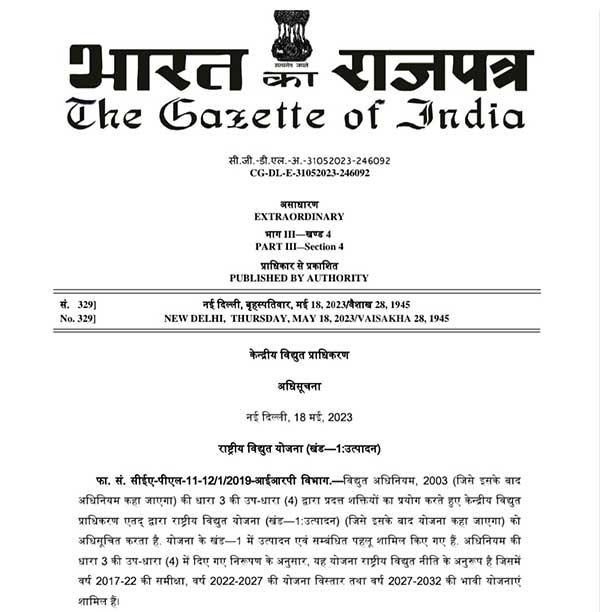 The Government of India has notified the National Electricity Plan (Generation) prepared by the Central Electricity Authority (CEA). NEP includes a review of the period 2017-22, detailed capacity addition requirements during 2022-27 and prospective plan projections for 2027-32.
The Government of India has notified the National Electricity Plan (Generation) prepared by the Central Electricity Authority (CEA). NEP includes a review of the period 2017-22, detailed capacity addition requirements during 2022-27 and prospective plan projections for 2027-32.
The scheduled capacity addition from conventional sources during 2017-22 was 51,561.15 mw as per NEP 2018. The capacity addition achieved from conventional sources is 30,667.19 mw for 2017-22. India’s cumulative capacity of renewable energy including large hydro as on March 31, 2022is 156,607.9 mw. This has increased to 167,750 mw as on December 31, 2022.

Capacity consisting of coal (18320 mw), hydro (4801.5 mw) nuclear (3300 mw) envisaged during 2017-22 has been slipped due to various reasons where COVID 19 being the major reason resulting in delay.
As per 20th EPS report, the projected electrician energy requirement and peak electricity demand on all India basis is 1907.8 BU and 277.2 GW respectively and 2473.7 BU and 366.4 GW for the year 2031-33 respectively. Projection of energy savings for utility and non utility is 213 BU for year 2026-27 and 304 BU for year 2031-32 in moderate scenarios and 285 BU for 2026-27 and 404 BU for the study period 2022-32.
Projection of energy savings for utility and non-utility is 213 BU for the year 2026-27 and 304 BU for the year 2031-32 in moderate scenarios and 285 BU for the year 2026-27 and 404 BU for the year 2031- 32 in the ambitious scenario.
The Installed Capacity of the country as on 31.03.2022 was 398,986.9 MW (excluding 510 MW of Diesel) comprising 235,599 MW thermal, 6,780 MW Nuclear and 156,607.9 MW renewable energy (including Large Hydro). This is considered as a base installed capacity for the study period 2022-32.
Under construction capacity considered for the studies consists of 26,900 MW (25,580 for 2022-27 and 1,320 for 2027-32) of Coal based power plants, 11,494MW (10,462 for 2022-27 and 1,032 for 2027-32) of Hydro Power plants, 2,780 MW (2700 for 2022-27 and 80 for 2027-32) of Pumped storage plants and 8,700 MW (6,300 for 2022-27 and 2,400 for 2027-32) of Nuclear Power plants. Additionally, solar and wind capacity of 117,580 MW (comprising 92,580MW of solar and 25,000MW of Wind) which are under various stages of implementation have been considered as planned capacity for the studies during the period 2022-27.
The retirement of 2121.5 MW has been considered for the period 2022-32.
The projected capacity addition requirement during the period 2022-27 to meet the peak demand and energy requirement for the year 2026-27 is 211,819 MW comprising of 31,880 MW of Conventional capacity (Coal-25,580MW and Nuclear-6,300MW) and 179,939 MW of Renewable based Capacity (Large Hydro- 10,462 MW, Solar-131,570, Wind-32,537 MW, Biomass-2,318 MW, Small Hydro- 352MW PSP-2700
MW) excluding likely Hydro based Imports of 3720MW. Additionally, the likely BESS requirement is 8,680MW/34,720 MWh during this period.
Based on generation planning studies carried out for the period of 2022-27, the likely Installed Capacity for the year 2026-27 is 609,591 MW comprising of 273,038 MW of Conventional capacity (Coal- 235,133MW, Gas 24,824MW, Nuclear-13,080MW) and 336,553 MW of Renewable based Capacity (Large Hydro-52,446 MW, Solar-185,566 MW Wind-72,895 MW, Small Hydro-5,200 MW, Biomass- 13,000MW, PSP-7446MW) along with BESS capacity of 8,680MW/34,720 MWh.
The projected capacity addition requirement during the period 2027-32 to meet the peak demand and energy requirement for the year 2031-32 is 291,802 MW comprising of 32,080 MW of Conventional capacity (Coal-25,480 MW, Nuclear-6,600 MW) and 259,722 MW of Renewable based Capacity (Large Hydro- 9,732 MW, Solar-179,000, Wind-49,000, Biomass-2,500 MW, Small Hydro-250 MW PSP-19,240 MW).
Additionally, there is likely to be a requirement of BESS based capacity addition of 38,564 MW/201,500 MWh during this period.
Based on generation planning studies carried out for the period of 2027-32, the likely Installed Capacity for the year 2031-32 is 900,422 MW comprising of 304,147 MW of Conventional capacity (Coal-259,643 MW, Gas 24,824MW, Nuclear-19,680MW) and 596,275MW of Renewable based Capacity (Large Hydro-62,178 MW, Solar-364,566MW, Wind-121,895MW, Small Hydro-5450MW, Biomass-15,500 MW, PSP-26,686MW; excluding 5856 MW of likely Hydro based Imports) along with BESS capacity of 47,244MW/236,220MWh.
Based on scenario analysis, it is seen that apart from under construction coal based capacity of 26.9GW, the additional coal based capacity required till 2031-32 may vary from 19.1 GW to around 27.1 GW across various scenarios.
Based on scenario analysis, in 2026-27, the BESS based storage requirement is varying from 2.1 GW/8.4GWh to 22.8 GW/ 91.2 GWh across various scenarios considered. In 2031-32, the BESS requirement is varying from 38.7 GW/193.55 GWh to 67 GW/335.2 GWh across various scenarios.
As per the generation planning studies, the energy storage capacity of 16.13 GW/82.37 GWh with PSP based storage of 7.45GW capacity and 47.65 GWh storage and BESS based storage of 8.68 GW/ 34.72 GWh is required by the year 2026-27. The storage capacity requirement increases to 73.93 GW (26.69 GW PSP and 47.24 GW BESS) with storage of 411.4 GWh (175.18 GWh from PSP and 236.22 GWh from BESS) by the year 2031-32.
According to generation planning studies, projected electricity generation to meet the projected electrical energy requirement during the year 2026-27 is 2025 BU which comprises of coal based – 1203.4 BU, Gas based-34.1 BU, Nuclear based- 77.9 BU, Large Hydro based- 207.7 BU (including generation from Hydro imports), PV based-339.3 BU, Wind based- 153.5 BU and Other RE-9.1 BU.
The average PLF of the total Installed coal capacity of 235.1 GW is likely to be about 58.4% in 2026- 27and that of 259.6 GW of coal based capacity is likely to be about 58.7 % in 2031-32.
The domestic coal requirement has been estimated to be 866.4 Million Tonnes for the year 2026-27 and 1025.8 Million Tonnes for the year 2031-32 and estimated requirement of 28.9 MT of coal imports for the plants designed to run on imported coal.
The total fund requirement for the period 2022-2027 is estimated to be Rs. 14,54,188 Crores, which also includes the likely expenditure during 2022-27 for advance action for the projects expected to get commissioned during 2027-2032.
The total fund requirement for the period 2027-2032 has been estimated to be Rs. 19,06,406 Crores. This fund requirement does not include advance action for the projects which may get commissioned after 31.03.2032,
Based on the estimation of fund requirement for the period 2022-27 and considering sector-wise equity contribution, it is estimated that developers will be required to infuse equity amount totalling to Rs. 3,63,547 Crores. Further, they will have to arrange for a total debt of Rs. 10,90,641 Crores.
The equity and debt requirement (excluding fund requirement for advance action for projects during the period beyond 31.03.2032) for the period 2027-2032 have been estimated as Rs. 4,76,602 Crores and Rs. 14,29,805 Crores respectively.
xxiii) The average CO2 emission rate from coal based stations in the country has been on a declining trend indicating improvement in efficiency of power generation from coal based power plants.
During 2021-22, the country achieved Fly Ash Utilization of 259.86 Million tonnes with percentage utilization of 95.95%.
The total CO2 emissions projected will increase from 1002 Million Tonnes in 2021-22 to 1057 Million tonnes in the year 2026-27 and 1100 Million Tonnes in 2031-32.
xxvi) The average emission factor is expected to reduce to 0.548 kg CO2/kWh in the year 2026-27 and to 0.430 kg CO2/kWh by the end of 2031-32.
The share of non-fossil based capacity is likely to increase to 57.4% by the end of 2026-27 and may likely to further increase to 68.4% by the end of 2031-32 from around 40% as on March 31, 2022.





























